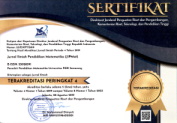UPAYA MENINGKATKAN PRESTASI BELAJAR MATEMATIKA DENGAN PENDEKATAN PROBLEM SOLVING
Abstract
Full Text:
PDFReferences
Caprioara, D. (2015). Problem solving - purpose and means of learning mathematics in school. Procedia – Social and Behavioral Sciences 191 (2015) (pp.1859- 1864).
Chambers, P. (2008). Teaching mathematics: developing as a reflective secondary teacher. London: SAGE Publications.
Evans, B. (2007). Student attitudes, conceptions, and achievement in introductory undergraduate college statistics. The mathematics educator 2007, Vol. 17, No. 2, 24-30. Diambil dari http://math.coe.uga.edu/tme/issues/v17n2/v17n2_Evans.pdf
Gronlund, N.E. (1982). Constructing achievement test. Englewood Cliffs. New Jersey: Prentice Hall
Intaros, P., Inprasitha, M. & Srisawadi, N. (2014). Students’ problem solving strategies in problem solving-mathematics classroom. Procedia - Social and Behavioral Sciences 116 (2014) (pp.4119 – 4123).
Jinfa Cai & Nie. (2007). Problem solving in Chinese mathematics education: Research and Practice. ZDM: Mathematical Education 39 (pp.459-473).
Joyce, B., & Weil, M. (1996). Models of teaching. Boston: Allyn and Bacon
Kemmis, S. & Taggart, R. (1991). The action research planner. Victoria University Press
Kemp, J. F., Morison, G. R., & Ross, S. M. (1994). Desain effective instruction. New York: Macmillan Publishing Company.
Kennedy, M.L., Tipps, S,. & Johnson,A. (2008). Guiding children’s learning of mathematics. New York, NY: Thomson Higher Education.
Killen, R. (2009). Effective teaching strategies: Lessons from research and practice (5th ed). South Melbourne: Cengange Learning.
Kirkley, Jamie. (2003). Principles for teaching problem solving. Technical paper: Plato Learning.
Marzano, et al. (2001). A Handbook for Classroom Instruction that Works. United States: Library of Congres Cataloging-in-Publication Data.
NCTM. (2000). Principles and standards for school mathematics. Reston, VA: The National.
Nitko., A. J, & Brookhart, S. M. (2007). Educational assesment of students. Boston, MA: Pearson (Merill Prentice Hall).
Nora, O. Z. (2014). Keefektifan pembelajaran dengan pendekatan problem solving dan penemuan terbimbing ditinjau dari prestasi, motivasi, dan minat belajar siswa SMP Muhammadiyah 2 Yogyakarta. Abstrak. Diambil dari http://eprint.uny.ac.id/id/eprint/12886.
Polya, G. (1973). How to solve it. New Jersey: Princeton Unirversity Press.
Pritchard, A. & Woollard, J. (2010). Psychology for the classroom: contructivism and social learning. New York: Routledge
Rathus, S. A. (2014). Childhood and adolescence voyages in development (5th ed). Belmont: Wadsworth Cengage Learning.
Rott, B. (2012). Models of the problem solving process a discussion referring to the processes of fifth graders. Proceedings from the 13th ProMath Conference, UMERC, (pp.95-109). Diambil dari http://umu.diva-portal.org/smash/get/diva2:594205/FULLTEXT01.pdf.
Skemp, R. (1971). The psychology of learning mathematics. Bungay, Suffolk:Richard Clay (The Chaucer Press) Ltd.
Suherman, E, dkk. (2003). Strategi pembelajaran matematika kontemporer. Bandung: Universitas Pendidikan Indonesia.
Sutherland, R. (2007). Teaching for learning mathematics. New York, NY: Open University Press.
Szetela, W. & Nicol, C. (1992). Evaluating problem solving in mathematics. ASCD: Educational Leadership. dari http://www.ascd.org/ASCD/pdf/journals/ed_lead/el_199205_szetala.pdf.
Young, M. (2015). What is learning and why does it matter? European Journal of Education, 50 (1), 17-20.
DOI: https://doi.org/10.26877/jipmat.v5i1.5889
Refbacks
- There are currently no refbacks.
JIPMat (Jurnal Ilmiah Pendidikan Matematika) Indexed by:
JIPMat (Jurnal Ilmiah Pendidikan Matematika) is licensed under a Creative Commons Attribution-ShareAlike 4.0 International License.




















